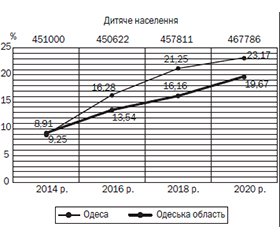Журнал «Здоровье ребенка» Том 19, №4, 2024
Вернуться к номеру
Програма оптимізації виявлення дефіциту гормону росту у дітей та підвищення комплаєнтності до замісної терапії
Авторы: Аряєв М.Л., Сеньківська Л.І., Сеньківська Ю.Д.
Одеський національний медичний університет, м. Одеса, Україна
Рубрики: Педиатрия/Неонатология
Разделы: Клинические исследования
Версия для печати
Актуальність. Поширеність низькорослості в дитячій популяції висока, становить 1–5 % і є різноманітною за етіологією. Перспективи остаточного росту дитини багато в чому залежать від ефективності системи діагностики та підвищення комплаєнтності до терапії. Мета: поліпшення діагностики дефіциту гормону росту (ДГР) у дітей та підвищення комплаєнтності до терапії рекомбінантним гормоном росту людини (рГРл) на основі інформації про регіональну поширеність захворювання та бар’єри формування комплаєнсу. Матеріали та методи. Дослідження виконані на базі КНП «Одеська обласна дитяча клінічна лікарня» ООР в 2012–2020 рр. До когорти увійшли 94 дитини з ДГР. Поширеність визначалася як відношення числа всіх виявлених випадків ДГР за цей період до чисельності дитячої популяції у перерахунку на 100 тис. дитячого населення. Комплаєнтність визначалася за даними шкали прихильності до терапії MMAS (Morisky Medication Adherence Scale). Статистична обробка результатів проведена з використанням методів t-test та ксі-квадрат (значення р < 0,05 вважалися статистично значущими). Результати. Оцінка поширеності ДГР, рівня комплаєнтності та частоти безперервності рГРл-терапії у дітей в Одеському регіоні на кінець 2014 року виявила неповноту регіональної діагностики захворювання (м. Одеса — 1 : 11 200; Одеська область — 1 : 10 800), а також недостатньо високу частоту прийнятної прихильності (57,4 %) та безперервності терапії (76,9 %). Ці дані були основою розробки регіональної програми оптимізації виявлення та ведення ДГР у дітей, яка включала організаційні та медико-соціальні заходи. На кінець 2020 р. показник поширеності ДГР у м. Одесі становив 1 : 4300, а на Одещині — 1 : 5100. Частота прийнятної комплаєнтності до терапії рГРл зросла до 80,0 %, а безперервності терапії — до 91,1 %. Висновки. Регіональна програма оптимізації виявлення та ведення ДГР у дітей поліпшує діагностику захворювання, підвищує комплаєнтність та частоту безперервності рГРл-терапії. Висока прихильність має біоетичний вимір, оскільки відбиває добре партнерство між лікарем, дитиною, батьками та демонструє повагу до автономії пацієнта.
Background. The significance of this study lies in the fact that short stature is highly prevalent among children, affecting 1–5 % of the population and having diverse causes. The child’s growth potential in the long term is largely depends on the effectiveness of the diagnostic system and the level of adherence to the prescribed therapy. The purpose was to improve the diagnosis of growth hormone deficiency (GHD) in children and adherence to recombinant human growth hormone (rhGH) therapy based on information about the regional prevalence of the disease and barriers to adherence. Materials and methods. A follow-up study was conducted from 2012 to 2020 at the Odesa Regional Children’s Hospital. The cohort included 94 children with GHD. The prevalence was determined by calculating the ratio of the number of all detected GHD cases to the children population per 100,000. Adherence was measured using the Morisky Medication Adherence Scale. The statistical processing of the results was done using t-test and chi-square methods, and p-values less than 0.05 were considered statistically significant. Results. An assessment of GHD prevalence, the level of adherence and the frequency of continuity of rhGH therapy in children in the Odesa region at the end of 2014 revealed the incompleteness of regional diagnosis of the disease (in Odesa, 1 : 11,200; in the Odesa region, 1 : 10,800), as well as a low level of acceptable adherence (in 57.4 %) and insufficient frequency of continuity of therapy (in 76.9 %). These data formed the basis of the regional program for optimizing the identification and management of GHD in children, which included organizational, medical and social measures. By the end of 2020, the prevalence of GHD in Odesa was 1 : 4,300, and in the Odesa region, 1 : 5,100. The rate of acceptable adherence to rhGH therapy increased to 80.0 %, and frequency of continuity of therapy to 91.1 %. Conclusions. The regional program designed to improve the detection and management of GHD in children has been found to improve the diagnosis of the disease, increase adherence to rhGH therapy, and the frequency of continuity of treatment. High adherence to treatment is a bioethical issue because it signifies a good partnership between physicians, children, and parents and indicates respect for patient autonomy.
діти; дефіцит гормону росту; медико-соціальні проблеми; замісна терапія; комплаєнс
children; growth hormone deficiency; medical and social problems; replacement therapy; adherence

